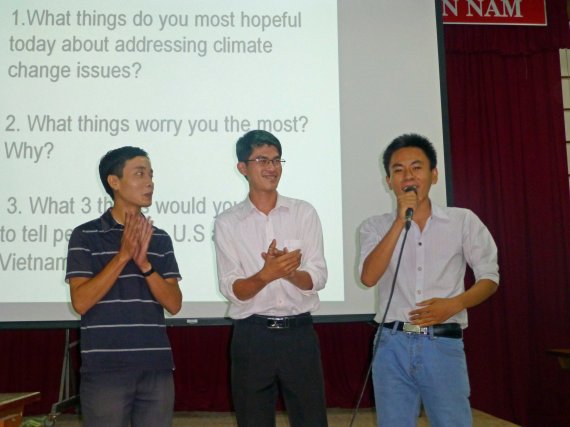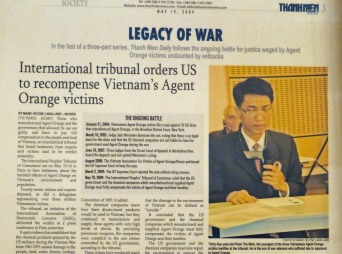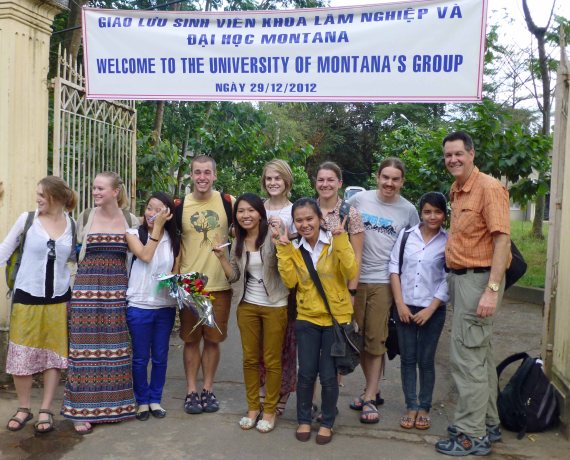Green Montana Meets Green Vietnam: Exchanges Between University Student Environmental Groups
Green Montana Meets Green Vietnam: Exchanges Between University Student Environmental Groups by Sara Anderson
Many of the students on this trip participate in one or more environmental or social justice student groups trying to  spark various kinds of change on our campus, in Missoula, at the state level, nationally or even internationally. We employ a huge range of tactics and collaborate with a wide range of organizations working towards similar ends. For me personally, the scale of many of the problems we are working to address is so large
spark various kinds of change on our campus, in Missoula, at the state level, nationally or even internationally. We employ a huge range of tactics and collaborate with a wide range of organizations working towards similar ends. For me personally, the scale of many of the problems we are working to address is so large  that I am constantly looking to share ideas about how to proceed and to find evidence that my fellow group members and I are not the only people who care about the issue and are not the only ones working to address it. As a student, I am particularly interested in the thoughts and efforts of other students, especially those who, like me, participate in student groups with the purpose of addressing the environmental and social issues of our time.
that I am constantly looking to share ideas about how to proceed and to find evidence that my fellow group members and I are not the only people who care about the issue and are not the only ones working to address it. As a student, I am particularly interested in the thoughts and efforts of other students, especially those who, like me, participate in student groups with the purpose of addressing the environmental and social issues of our time.
With this in mind, I was anticipating meeting with the 350.org group at Nong Lam University in Ho Chi Minh City (http://www.350.org/en/node/27549). Dan had met with them the prior year and returned with a picture of about 20 group members in matching shirts. When we met the students at Nong Lam, though, only one was wearing the 350.org shirt.  One of the other students spoke about the environmental activities of the university, including the participation of 1000 students in Earth Hour (http://www.earthhour.org/), a waste recycling day in 2012 including teaching about the three ‘t’s (Tiết giảm – Tái sử dụng – Tái chế or Reduce – Reuse – Recycle), and planting trees in the mangrove preserve we visited, Can Gio.
One of the other students spoke about the environmental activities of the university, including the participation of 1000 students in Earth Hour (http://www.earthhour.org/), a waste recycling day in 2012 including teaching about the three ‘t’s (Tiết giảm – Tái sử dụng – Tái chế or Reduce – Reuse – Recycle), and planting trees in the mangrove preserve we visited, Can Gio.
After the formal presentations, we took a walk around the campus and I was able to chat with the lone 350.org shirt wearer. As it turned out, the group was no longer in existence because it had lost the university’s support and funding due to the presence of two other department (Environment and Forestry) sponsored environmental groups operating on the campus. I found this limitation to be particularly interesting given that it sometimes seems that our campus has an environmental or social action group for every student who cares to participate in one, each with a slightly different focus but all with the same general aim: creating and preserving a livable future.
She did say that the roles of the 350.org group were being performed by the other environmental groups. I didn’t ask if she had joined one of the other groups or how many students participate in the two groups or how the activities of the environmental groups were received by the other students.
 At Can Tho University we met with another group of students. The president of the environmental club, a business student, told us a bit about the work the club does. They were focused on cleaning up the campus and educating the students about the amount of trash on campus so they would take care of the land and not litter. The club was also working on a larger project to clean up trash from the river running through Can Tho.
At Can Tho University we met with another group of students. The president of the environmental club, a business student, told us a bit about the work the club does. They were focused on cleaning up the campus and educating the students about the amount of trash on campus so they would take care of the land and not litter. The club was also working on a larger project to clean up trash from the river running through Can Tho.
The most valuable conversation I had was with a biotechnology student who had a very thoughtful take on the effectiveness of the environmental club. She said it was a very small group, composed largely of students outside the environmental major who just cared about the environment.  She suggested the club should work to recruit members from the environment department in order to benefit from their greater knowledge from their studies as well as the greater degree of authority their membership would confer on the group. The participation of environmental studies students would also help gain further support from the university and possibly also more funds which would help them pursue bigger projects and recruit more members from diverse programs across the university and get the word out about their group and the work they are doing.
She suggested the club should work to recruit members from the environment department in order to benefit from their greater knowledge from their studies as well as the greater degree of authority their membership would confer on the group. The participation of environmental studies students would also help gain further support from the university and possibly also more funds which would help them pursue bigger projects and recruit more members from diverse programs across the university and get the word out about their group and the work they are doing.
 We also talked about the attitudes of people in Vietnam who didn’t participate in the environmental groups. She highlighted the importance of early education about environmental issues, telling me people who didn’t learn to be concerned about the environment in primary and secondary school weren’t going to suddenly develop an interest when they got to college. Here, as in the US, people have other concerns. The specific details of the environmental problems we face vary from place to place as do the cultures that shape peoples’ motivations, but we share one primary challenge: getting people involved.
We also talked about the attitudes of people in Vietnam who didn’t participate in the environmental groups. She highlighted the importance of early education about environmental issues, telling me people who didn’t learn to be concerned about the environment in primary and secondary school weren’t going to suddenly develop an interest when they got to college. Here, as in the US, people have other concerns. The specific details of the environmental problems we face vary from place to place as do the cultures that shape peoples’ motivations, but we share one primary challenge: getting people involved.
I know the students at both universities were excited to meet us and exchange ideas. The presenter at Nong Lam University thought our visit was so important that she wanted to be able to communicate directly with us and had carefully written out her whole speech in English so she would be able to say everything correctly.  It makes me wonder what more we would have been able to share if we had more time together, either just a few more hours so we didn’t have to squeeze getting to know each other a bit and talking about the environment into the same short period of time or even a few weeks to establish a small amount of shared experience and have the potential for conversations to rise naturally out of that experience.
It makes me wonder what more we would have been able to share if we had more time together, either just a few more hours so we didn’t have to squeeze getting to know each other a bit and talking about the environment into the same short period of time or even a few weeks to establish a small amount of shared experience and have the potential for conversations to rise naturally out of that experience.
Agent Orange Lingers Decades After Vietnam War
Agent Orange Lingers Decades After Vietnam War by David Schaad
During our time together in Vietnam´s urban and rural environments, several of us have remarked to one another about how easy it seems as outsiders to forget that less than 40 years ago, this country was in the throes of a costly and brutal war. Vast, lush mangrove forests in particular, recently reborn from expansive war-borne wastelands, make the war seem like a distant dream.
 Still, the wounds and losses of war remain painfully vivid in many people´s lives today. In particular, the ongoing issues and concerns surrounding the use of chemical defoliants by the United States military are impossible to escape.
Still, the wounds and losses of war remain painfully vivid in many people´s lives today. In particular, the ongoing issues and concerns surrounding the use of chemical defoliants by the United States military are impossible to escape.
For a decade ending in 1971, U.S. military aircraft sprayed 72 million liters (20 million US gallons) of concentrated defoliants over thousands of square miles of forest and farmland – 16% of South Vietnam in total and nearly 19% of all of Vietnam´s forested terrain –  to erase the natural cover of Viet Cong forces. (The Viet Cong, also known as the National Liberation Front (NLF), sought to reunite South Vietnam with the North as a single unified nation under communist rule). This offensive would become the most concentrated effort to obliterate a nation´s natural ecology in the history of humankind.
to erase the natural cover of Viet Cong forces. (The Viet Cong, also known as the National Liberation Front (NLF), sought to reunite South Vietnam with the North as a single unified nation under communist rule). This offensive would become the most concentrated effort to obliterate a nation´s natural ecology in the history of humankind.
Agent Orange was only one of several defoliants used during this decade, four of which contained dioxin – but it was the most widely used and has therefore received the most attention. Many have deemed dioxin (actually 2-3-7-8 tetra chlorodibenzo-p-dioxin or TCDD) to be among the most deadly and harmful of all known substances known to humankind. A mere 85 grams of TCDD would be sufficient to kill a city of 8 million..
Many have deemed dioxin (actually 2-3-7-8 tetra chlorodibenzo-p-dioxin or TCDD) to be among the most deadly and harmful of all known substances known to humankind. A mere 85 grams of TCDD would be sufficient to kill a city of 8 million..
Japanese photographer Goro Nakamura cites that four million Vietnamese have been adversely affected by Agent Orange, though it is likely that this number does not account for more recent cases. Dioxins are persistent environmental toxins, meaning that they do not quickly disintegrate or disperse from sites sprayed during the war and can linger in sediments and soils, both on land and under water, for generations. Dioxins accumulate in fatty tissue and enter the food chain through the animals or fish that feed in affected areas; they also biomagnify up the food chain.
 Agent Orange residues in the soil which have remained long after the war have exposed many farmers and their families to TCDD unknowingly, and while many of these people have continued to appear healthy, they give birth to deformed, even stillborn children with mutated DNA. Those who live past birth may look as though they have leprosy, while others are troubled by mental disorders; deformed limbs, bodies or faces; congenital blindness;
Agent Orange residues in the soil which have remained long after the war have exposed many farmers and their families to TCDD unknowingly, and while many of these people have continued to appear healthy, they give birth to deformed, even stillborn children with mutated DNA. Those who live past birth may look as though they have leprosy, while others are troubled by mental disorders; deformed limbs, bodies or faces; congenital blindness;  Parkinson´s and heart diseases; or other conditions which either allow for a severely reduced life span or require constant care from family members, rendering these individuals vulnerable and disabled, and putting emotional and resource strains on their families.
Parkinson´s and heart diseases; or other conditions which either allow for a severely reduced life span or require constant care from family members, rendering these individuals vulnerable and disabled, and putting emotional and resource strains on their families.
Vietnamese victims have sued 37 chemical companies, most notably Dow Chemical and Monsanto, hoping to receive compensation for suffering birth defects, congenital diseases,  and aforementioned genotoxic (multi-generational) effects. The U.S. Supreme Court absolved the chemical companies of any such liability, although these companies did pay out a US$180 million sum to compromised U.S. soldiers who fought in Vietnam.
and aforementioned genotoxic (multi-generational) effects. The U.S. Supreme Court absolved the chemical companies of any such liability, although these companies did pay out a US$180 million sum to compromised U.S. soldiers who fought in Vietnam.
Recently, though highly overdue, an important first step was made towards permanent cleanup of residual TCPP in Vietnam. In June of 2012, the United States government finally committed to a dioxin removal project, which will extract dioxin from 71 acres of land at the airport in Danang, Vietnam, the previous site of a U.S. military base. The project will require four years to carry out and carries a price tag of $32 million. Other former U.S. air bases have been identified with alarming concentrations of dioxin, which continues to seep into the surrounding soil and neighboring waterways, but no further cleanup has yet been guaranteed by the United States.
A far more comprehensive and substantial effort will be required to repair damaged soils and waterways. A recent estimate by the Aspen Institute determined that the U.S. Government would need to spend nearly ten times the cost of this first project to eliminate the remaining toxic dioxin concentrations in  Vietnam and provide compensation to disabled Vietnamese.
Vietnam and provide compensation to disabled Vietnamese.  While families of retired U.S. soldiers receive up to US$1,500 per month in compensation for Agent Orange related health issues, Vietnamese families who are lucky enough to receive financial assistance take in a meager $5US in the same time period to support disabled children.
While families of retired U.S. soldiers receive up to US$1,500 per month in compensation for Agent Orange related health issues, Vietnamese families who are lucky enough to receive financial assistance take in a meager $5US in the same time period to support disabled children.
While we cannot undo the evils of the past, as U.S. citizens we still have a crucial role to play with regard to the cleanup of Agent Orange. Our government and our chemical companies brought this tragedy on the people and ecosystems of Vietnam, albeit before most of us were born. Bestowed with great privilege as Montanans and as Americans, blessed with healthy landscapes and political influence, we must put continued pressure on the Obama Administration to fund and support the bioremediation of this toxic chemical to the fullest extent possible.  We also ask that appropriate financial compensation and resources be given to the Vietnamese who lost so much and who are left to care for their disabled family members. This is what we owe the Vietnamese people as a strong and wealthy nation, as friends, and as fellow human beings. The pursuit of justice in the wake of the war demands that we restore affected lands to full health and empower the victims of Agent Orange to the fullest extent possible.
We also ask that appropriate financial compensation and resources be given to the Vietnamese who lost so much and who are left to care for their disabled family members. This is what we owe the Vietnamese people as a strong and wealthy nation, as friends, and as fellow human beings. The pursuit of justice in the wake of the war demands that we restore affected lands to full health and empower the victims of Agent Orange to the fullest extent possible.
~~~~~~~~~~~~~~~~~~~~~~~~~~~~~~~~~~~~~~~~~~~~~~~~~~~~~~~~~~~~~~~
INFORMATION SOURCES:
Lonely Planet Guidebook
War Remnants Museum, particularly:
“Agent Orange in the Vietnam War” by Goro Nakamura (panel at the War Remnants Museum, Ho Chi Minh City, Vietnam).
PLUS: WEBSITES:
http://www.who.int/mediacentre/factsheets/fs225/en/
http://makeagentorangehistory.org/about-agent-orange/agent-orange-dioxin/
Wikipedia: http://en.wikipedia.org/wiki/Agent_Orange
http://www.theasian.asia/archives/28149
http://www.huffingtonpost.com/2011/06/17/agent-orange-cleanup-vietnam-us_n_879116.html
http://www.independent.co.uk/news/world/asia/the-terrible-legacy-of-agent-orange-8034869.html




You must be logged in to post a comment.